“This historic investment in walking, biking, & transit puts [Oregon] on the map as a leader in accessibility & active transportation.
— The Street Trust via Twitter
It’s no small task that Oregon legislators passed a $5.3 billion transportation package last week. We haven’t had a new way to fund transportation projects and programs since the Jobs and Transportation Act passed in 2009 and this year’s bill was nearly dead just days before being resurrected thanks to a few major compromises.
But a small part of House Bill 2017 — a $15 tax on new bicycles — has gotten a lot of attention from transportation reformers (did you see the tweet from former New York City DOT Director Janette Sadik Khan?!). And for good reason. The tax an unprecedented step in the wrong direction from a state previously famous for passing the forward-thinking “Bicycle Bill” way back in 1971. And while our debates and discussions about the bike tax will continue, let’s not forget the other major components of this bill.
After all, there had to be something good in the bill for The Street Trust and other progressive nonprofit groups to support it.
So… What exactly did they come away with? Here’s how transit, biking, and walking fared.
Transit: Better bus service coming soon
A new employee-paid payroll tax of 0.1 percent (about 39 cents per week for a minimum wage earner) will raise $1.2 billion over 10 years. This is the best news in the bill for transportation reformers by far.
That level of investment is “Truly a game-changer” says the national nonprofit Transportation for America. According to their numbers it moves Oregon up to 13th (from 19th) in per capita spending countrywide.
The new funding is earmarked specifically for projects that make bus service better (light rail, streetcar, and bike share aren’t eligible). Lawmakers wrote language into the bill to make sure the money is spent to reduce fares and increase frequency and service range of bus service for communities with a high percentage of low-income households and purchase buses powered by natural gas or electricity.
In our region, TriMet says they plan to do just that. In a statement released on July 7th the agency said they expect an additional $35-40 million annually from the bill. And the Portland Bureau of Transportation says they’ll team up with TriMet to make sure the investments align with their ongoing plans to, “make more bus-only lanes and transit priority traffic signals that will improve bus service by helping buses get through rush-hour congestion.”
But the real winners are the smaller, rural transit providers who struggle to find any funding whatsoever. To them and the people they serve, this new source of money could be the difference between some transit and no transit at all.
Advertisement
Safe Routes gets a boost
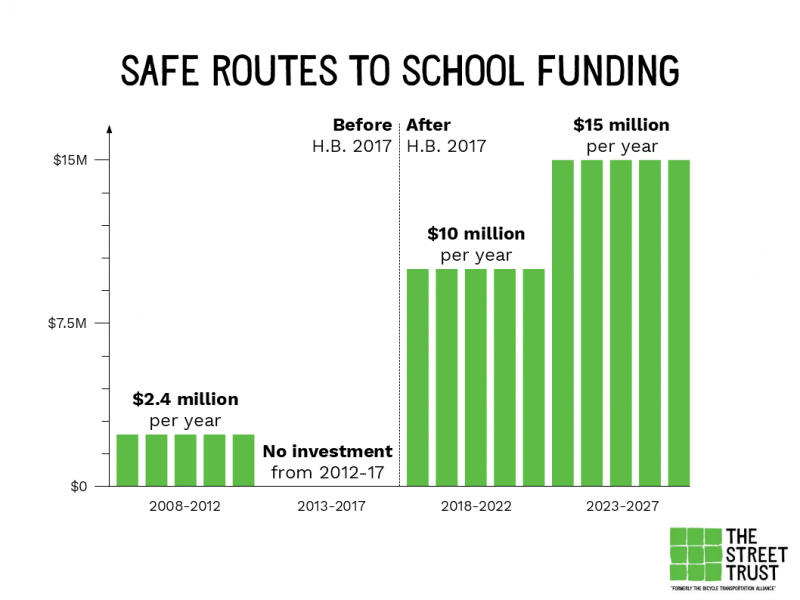
HB 2017 marks a significant boost for Safe Routes to School project funding. The most ever in Oregon by far. Thanks in large part to a concerted advocacy push by The Street Trust (creators of the graphic above), Oregon will now invest $10 million per year in Safe Routes to School projects through 2021 and the amount will bump up to $15 million per year from 2022 to 2027.
The funds will be put into a competitive grant program (Oregon has about 1,200 public schools) and only projects within one-mile of a school will be eligible.
Local cities and counties will have to dig up a 40 percent match if they want to access these funds. A 20 percent match will be required if the school has a majority of low-income students, the project is on a designated safety corridor, or the town has 5,00 or fewer residents.
While it’s not everything advocates wanted (they wanted even more funding and hoped it would pay for educational and marketing programs too), this is a very big deal. “This level of ongoing, dedicated investment for school travel safety — and the positive impacts it will have on the health and safety of our communities — is unprecedented in Oregon,” wrote the Safe Routes National Partnership. “This is a big step in the right direction for the hundreds of thousands of students in Oregon.”
Funding for off-highway paths and trails
The Street Trust estimates that the bill will lead to $7 million per year for “trails” — a term generally used to refer to multi-use paths like the Eastbank Esplanade and Springwater Corridor.
Despite how it’s being reported as “funding for bike lanes” there’s no money in this bill set aside specifically for on-street bicycle infrastructure like protected bikeways (other than those that might be built as part of other funded “highway” projects via the 1971 Bicycle Bill).
The bill sets aside the $1.2 million per year raised by the bike tax and guarantees that biking and walking projects will receive 7 percent of the total grant fund in the Connect Oregon program, which averages about $70 million every two years. Connect Oregon is a lottery-backed program used to fund projects that can’t be funded with the gas tax because they are not in the public highway right-of-way. To make it clear that on-street bike projects aren’t eligible for the funds, the bill states that, “The [Oregon Transportation] commission may award grants only for bicycle and pedestrian transportation projects that expand and improve commuter routes for nonmotorized vehicles and pedestrians, including bicycle trails, footpaths and multiuse trails.”
While we believe the intention of lawmakers was to only fund paths like the Esplanade and Springwater, the term “commuter routes” isn’t defined in the Oregon Vehicle Code and it remains to be seen what type of projects actually get funded.
A few steps forward, but status quo remains
While there are wins here for transportation reformers, about 80 percent of the funds raised by the bevy of new taxes and fees in the bill are business-as-usual and will go largely toward projects that maintain the automobile-related status quo.
It’s important to keep in mind that the only new, bike-specific funding in the bill is the $1.2 million per year raised by the bike tax. And there’s no new money here for bike-specific, transportation-related infrastructure. The Safe Routes money will be limited to biking and walking projects within one-mile of a public school. The other bike-related investments in the bill — the Connect Oregon money, and the 1 percent Bike Bill set-aside — are continuations of existing law. The fact remains that there’s no new money in this bill dedicated to the type of on-street bike infrastructure we need more of all over Oregon: high quality protected lanes.
On one hand we have an unprecedented investment in public transit and Safe Routes to School, and on the other we have a tax on bicycles and nearly one billion earmarked for freeway and highway projects (more on those in a separate post). It’s a mixed bag for sure. Advocacy groups like The Street Trust say it’s a good compromise.
In a Twitter thread posted earlier today, The Street Trust defended their support of the bill after initial reactions were dominated by talk of the bike tax.
“Let’s be frank: the $15 bike tax is very disappointing,” they wrote. “It’s also well worth the investments in bike safety & accessibility.” Other tweets explained why: “Many legislators refused to consider supporting the package if it didn’t include this tax, leaving us with a difficult choice… Rather than abandon effort to secure these investments, we made difficult decision to support HB2017… This is also the first time #orleg has been so receptive to addressing needs & concerns of advocates for biking, walking, & transit… This historic investment in walking, biking, & transit puts OR on the map as a leader in accessibility & active transportation.”
Stay tuned for more coverage of this and other bills.
— Jonathan Maus: (503) 706-8804, @jonathan_maus on Twitter and jonathan@bikeportland.org
BikePortland is supported by the community (that means you!). Please become a subscriber or make a donation today.



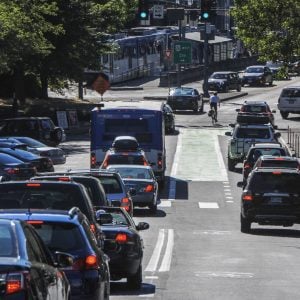
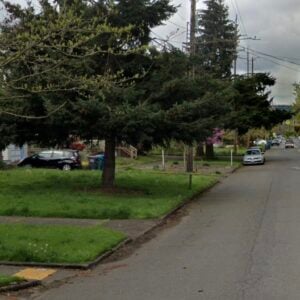
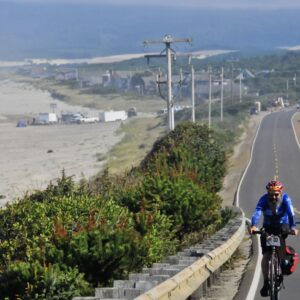
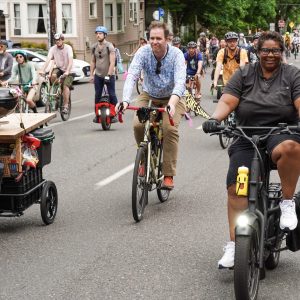
Thanks for reading.
BikePortland has served this community with independent community journalism since 2005. We rely on subscriptions from readers like you to survive. Your financial support is vital in keeping this valuable resource alive and well.
Please subscribe today to strengthen and expand our work.
Another related analysis of funding can be made by taking each funded project and breaking them down to see if new sidewalks and bikeways are being added (for example, outer Powell.)
Most modifications and paving inside of City Limits require full ADA upgrades and sidewalks because of the recent lawsuit that requires all ODOT intersections to be up to standard by 2035. Even local agency projects funded through the Transportation Bill will be subject to ADA requirements because the money will be administered through ODOT. Bike lane installations at the ODOT level are controlled by local Transportation System Plans.
Now that the $15 bike sales tax has passed we as a community draw a red line in the sand to prevent this from morphing in to something really damaging and retrograde. In other words we must make a stand to not compromise in terms of allowing the amount to be raised, or for it to be converted in to some form of bike registration, or annual cycling fee.
Sorry Street Trust, but 80% going to fuel auto-dependance and induced demand is nowhere near a “good compromise”.
Even if it was a 33/33/33 split between driving/cycling/transit, it would still be a stretch to call it a compromise considering how much automobile beneficiaries have been enjoying their massive funding and legal privilege for the past 50+ years.
As per on occasion, I totally agree with you. At least it’s nice to see more streets being converted to paid parking. If drivers really were paying their way for infrastructure maybe this tax wouldn’t be such a big deal. I mean, it’s only $15. But drivers are so used to getting so much infrastructure catered to them that they don’t even notice everything they get. I am a driver as well and appreciate that there’s good infrastructure for driving, but I’d be happy to sit in traffic longer as a driver if the trade-off was that bike commuting was safer. Like getting rid of the gaps on Barbur or clearing the bike lanes of gravel after the snow. I’d accept an extra five to ten minutes in the car because ultimately I don’t think I’d have to. I think if cycling seemed safer to people they’d get out of their cars. I wonder if there are any examples of such an experiment somewhere in the world… hmmm…
That it’s only 80% is exactly what makes it a good compromise — it represents a shift in the right direction even if more shifting is needed.
Hm.
If climate disaster weren’t staring us in the face I might agree, but this is 2017. Come on folks!
“about 80 percent of the funds […] will go largely toward projects that maintain the automobile-related status quo.” = f#(&ing disaster
I like the rural bus funds the best of all, but what good will buses do on a dead planet?
The devil is in the details.
I like the idea of providing buses in rural areas, but the fact of the matter is that there are relatively few people who are spread out and the distances they have to go are far. As a practical matter, that means that buses can’t run often or else they’ll be running empty — in which case the buses could have a worse impact than cars. It also means that most people have significant distances at one or both ends of their bus trip to deal with.
The other issue you run into in rural areas is that buses aren’t good for much beyond commuting. When you live a significant distance from where you buy food and other stuff, you need to stock up because the trip takes so long.
I can see buses working for bedroom communities since these have a number of people that need to cover about the same route at the same time. But vanpools can serve a lot of these needs better because the timing and routing meet the specific needs of the riders more precisely which allows significant savings on door to door times.
That trails funding is great news for the the North Portland Greenway (http://npgreenway.org), as so much planning is already in place. Considering that PBOT is already planning on adding a separated cycle track to the east side of N Greeley, it feels like a natural project to pick up. I hope it can happen soon!
Only two segments of NP Greenway (Kelley Point to Chimney Park and Cathedral Park to Swan Island) would be eligible for ConnectOregon, since the other segments run in street right-of-way. That is, assuming we go with the Greeley alignment for the innermost segment.
I hope this won’t mean that TriMet’s plans for Bus 56 to connect to Sylvan and Washington Park will be delayed just because the future route travels by million dollar homes.
We need a Bicycle Bill 2.0 that creates a mandate for all roads in the state: x traffic volume + y speed = z facility for pedestrian and cycling.
Great news for some Vancouver and Camas, Washington bicycle stores.
….not sure the (2) Camas and Vancouver independent bike retailers will be selling that many new bikes to Portlanders…now that its a $15 flat fee vs 5% of value…given the limited selection* AND bridge traffic…
*Portland still has 30x the number of independent bike retailers than Clark County…so much more selection…
Both those cities have an 8.4% sales tax. Even at the exact threshold this tax is triggered in Oregon ($200), you’d pay $16.80 in Washington sales tax (state & local combined rate). Also, the Oregon tax goes to bicycle projects, after administration fees.
Last time I checked Oregonians are exempt from Sales Tax in WA by showing their license.
This is what I kept saying at the state capital. The bike tax *will* hurt Portland retailers. How much exactly will have to be seen.
Just as I’d never drive out of Portland to avoid a 10 cent gas tax, I’d never trek over to Washington to save 15 bucks on a new bike. Obviously just a single anecdote, but I’ll be surprised if it has much impact. We should focus on making sure online retailers assess the new tax (as they do–sometimes–for other sales taxes), as that’s the bigger concern than Washington.
Precisely. Anyone driving over the river to save $15 is doing so on principle alone as you’ll lose a chunk of that money in gas (not to mention lost time). Also, since we’re all so concerned about the evils of the automobile, how are you getting to Vancouver/Camas to purchase said bicycle? Surely you’re not arguing that in order to avoid the tax you will be willing to pollute the air by driving unnecessarily out of state?
Even ignoring the time it takes to make the trip, the actual amount saved will be significantly less due to the cost of operating the vehicle. Plus, you then have to go to WA for service and support for the sale.
An earmarked income tax is another way non-motorists and/or low-mileage motorists will subsidize all the high mileage motorheads.
And make no mistake, TriMet is squarely aligned with the motorheads.
=> http://trimet.org/beseen/#1
barf.
The money raised by the bike tax would do more for safe bike infrastructure if it paid for a lobbyist and campaign contributions rather than paying for “trails.”
One doesn’t get a proverbial “seat at the table” by paying a tax. “A seat at the table” is bought directly from the legislators. Don’t be surprised when a seat at the table costs $30 next year.
I expect the initiative process will be used to repeal the payroll tax, the auto tax, the gas taxes and the entire program. Don’t count on seeing any new money or new projects.
Can we use the initiative process to put the kaibosh on the freeway widening boondoggles, the one big chunk of this that is most certainly going to not deliver the goods?
Sure, poot it on the ballot.
Exactly. Any idiot can propose a law or Constitutional amendment, and many have. Heck, our Constitution was riddled with misspelled words and grammatical mistakes that would embarrass a 10 year old until 2012 when they actually corrected them.
“..improve commuter routes for nonmotorized vehicles and pedestrians, including bicycle trails, footpaths and multiuse trails.”
Can anyone provide examples of nonmotorized “bicycle trails” within the State of Oregon that are not also “multiuse trails”? I’m confused by the distinction and phrasing.
No, but did they just accidentally fund new Forest Park single-track trails? I could definitely commute on them!
you can commute on them now, be polite if you do
Can anyone provide examples of nonmotorized “bicycle trails” within the State of Oregon that are not also “multiuse trails”? I’m confused by the distinction and phrasing.
The language is outdated and should read… “improve commuter routes for bikers and pedestrians, including bikeways, walkways and multiuse trails.” (A bikeway almost always refers to on-road bike infrastructure like a painted bike lane.) So the reference is to improving infrastructure for bikers (primarily on-road), not that bikers have exclusive “nonmotorized trails.”
Nope, that doesn’t work because ConnectOregon can’t be used for in-roadway bike lanes or sidewalks. Pretty much only can be used for off-street trails or ped/bike bridges.
Nobody bothered to divide $5.3 billion by 4 million (population of Oregon)
Well that happens to be $1,325 per person. This is a tax grab attached to pretty promises.
So you’re not a fan of infrastructure spending?
You didn’t bother to divide by 10 (years)? That happens to be $132.50 per person, and it’s most certainly not distributed equally. I fail to see the problem.
Jonathan got the attention of national talk show host Michael Berry today. Michael was poking fun at the $15 bike tax, and I heard him mention Jonathan. I heard him talk about it at 4:30 pm today on 1190 AM. His show starts at 3:00 I think, so counting commercials may have been about an hour into it. Have to have iheart radio to listen to it. Probably in this link:
https://www.iheart.com/podcast/139-The-Michael-Berry-Show-27764850/episode/the-michael-berry-show-am-071117-28302292/
But may be in this one:
https://www.iheart.com/podcast/139-The-Michael-Berry-Show-27764850/episode/the-michael-berry-show-pm-071117-28303573/
Michael is on each day 3 to about 7 pm. He’s a good ol’ boy from Texas. Has good music between talking sessions.
The Street Trust said that, “Many legislators refused to consider supporting the package if it didn’t include this tax.”
Do we know which ones? I find it hard to believe that legislators would have put an entire $5.3 BILLION bill in jeopardy in favor of a $1.2 million line item.
Having seen the bicycle tax rear its ugly head in past sessions, I thought it would disappear, having been consumed as a bargaining chip for other line items, just prior to the bill’s passage.
Apparently many legislators heard complaints about bikers not paying their fair share or some nonsense. I think several Republicans would have balked at bike infrastructure improvements without the tax. Yes, it’s ridiculous, but that was the rationale.
Lots not to like about this bill — especially the huge portion going to car infrastructure. And while I applaud any spending on transit, the restrictions put on it will blunt its effectiveness. Why, for instance, do we prioritize rural, low-income communities? It sounds more socially just, and no doubt works politically in a mostly rural state, but transit works best in densely populated areas, obviously. And Portland does not have the lowest incomes in the state — even if it has plenty of residents who make nominally good wages who can’t afford rents. The point is: you could double up peak-hour bus service on streets like Sandy blvd. and still run full buses, while you could add brand-new routes in Grants Pass and end up with buses carrying next to nobody. Jarrett Walker calls this the “intrinsic geometry of transit.”
Same with the restriction that all buses be natural-gas or electric. Can we not leave this to the market and simply let TriMet buy as many buses as funding allows? Again, the goal should be getting commuters out of cars and onto transit — which already brings community and environmental benefits. Why put in a restriction that will limit your capacity?
Another perspective in this article in WW.
http://www.wweek.com/news/state/2017/07/12/people-priced-to-the-edge-of-portland-are-now-facing-the-prospect-of-tolls/
I do not understand this comment: “”We should be looking to fund further public transit” with the tolling revenue, she says. (That could be difficult. Under the Oregon Constitution, tolls must go directly back into roads. Expanding roads to create dedicated bus lanes is allowed, however.)”
Money is fungible. To the extent tolls bring more money for road spending, the Legislature can allocate less from other sources to roads and more to transit.
An interesting tool showing percent of transportation spending on transit, roads, bridges, etc.
http://www.trackstatedollars.org/
According to this, Oregon spends its transportation dollars thus:
Bridge maintenance 11%
Roadway maintenance 21%
Transit 33%
New road capacity 8%
Bike/Ped 5%
Roadway w/ bike/ped components 1%
Safety 8%
Bridge Expansion 2%
Other 11%
I haven’t looked into the sources or accuracy of this tool.
“Despite how it’s being reported as “funding for bike lanes” there’s no money in this bill set aside specifically for on-street bicycle infrastructure like protected bikeways (other than those that might be built as part of other funded “highway” projects).”
So this really wasn’t about on-street cyclists putting some “skin in the game”? I suppose the skin from my hip that a Subaru helped my apply to the roadway will have to do for now…
The 80 percent to promoting driving/pollution is a terrible subsidy to increase global warming. The flat payroll tax is a highly regressive tax (not graduated like an income tax) that will hit the poor the hardest. The bike tax is flat awful. The Street Trust, Governor and Democrats screwed Oregon.
Not one cent of that 0.1% will go to transportation or bikes. Every cent will go to bailing out PERS.
However, if the article is right, I guess the 39 cents per week for a minimum wage earner will not break them. The po’ can pay for PERS. That’s fair, right? 🙂
at least you freeloaders will FINALLY pay something.
please show your math.